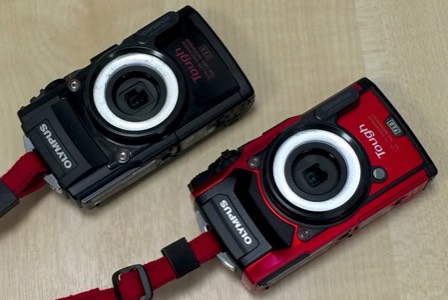Weatherproof cameras for field documentation
Comparison of Olympus TG-4 and TG-5 cameras for handheld collection of extended focus macrographs

The camera was updated to the TG-5 model in mid-2017. The two models are shown at the right (TG-4, black body and TG-5, red body). I compared the image quality and focus stacking abilities of the two models, and data are shown below.
The main potential improvements found in the TG-5 model are:
(i) High-speed back-lit CMOS image sensor (down to 12 Megapixel from 16 Megapixel, with larger pixel size and better low light performance), and the latest high-speed TruePic VIII image processor, similar to that found in the Olympus OM-D E-M1 Mark II DSLR camera.
(ii) Field sensor system, which can add tracking information for altitude, water depth, GPS location, temperature and digital compass to images - which can be mapped using a smartphone app, and potentially useful for field collections.
(iii) Movie shooting functions including 4K movie and full HD, high-speed, 120 fps movies.
(iv) Generic micro USB connector, instead of proprietary connector for charging and data transfer.
(v) Release lock for lease accessories like the LG-1 LED illuminator.
(vi) Variable Macro System for recording microscopic subjects
Largely unchanged from the TG-4, the Olympus Tough TG-5 is equipped with four macro modes:
1. Microscope mode. This mode lets you shoot subjects from up to 1 cm away from the end of the lens and use the optical zoom to enlarge and shoot subjects. This feature is perfect for shooting parts of an insect, the veins in a leaf, snowflake crystals, and other details of the natural world that cannot be seen with your eye.
2. Microscope control mode. This mode uses the rear LCD monitor to magnify and display microscopic subjects. For example, you can magnify a subject that is only 1 mm in size up to a maximum of approximately 44.4 mm when displayed on the rear LCD monitor. You can also check the display magnification on the LCD monitor when the subject is 1 cm away from the end of the lens. In addition to switching the magnification factor with the zoom lever, the arrow pad can also be used to switch between 1x, 2x, and 4x with the press of a single button as if changing the objective lens on a real microscope.
3. Focus stacking mode. The depth of field becomes shallow in macro shooting. Focus stacking mode, however captures eight different shots continuously while shifting the focus from the foreground to the background. Then, only the areas in focus are extracted and merged so that a full pixel (12 million pixel equivalent) photo is captured with a greater depth of field (examples of this mode are shown below).
4. Focus bracketing mode. With a single shot, this function captures up to 30 images while shifting the focus from the foreground to the background. You can select the shift amount and number of shots in three levels. This mode is convenient for focusing on low contrast subjects such as flower petals that consist of a single colour only.
However, the image collection and in-camera processing steps are noticeably faster, and image quality appears slightly improved. Further, the TG-5 offers monitoring of the image collection process, while the TG-4 is blind during collection of extended focus images. The HDMI connection makes it possible to view images (live view image) in 4K resolution on a large screen. With the LED Light Guide, LG-1, it is possible to observe a subject on a flat surface with the camera covering the subject.
Comparison of in-camera image stacking for Olympus TG-4 and TG-5 cameras
Above: TG-4 single image (left) and auto image stacking (right)
Above: Olympus TG-5 single image (left) and auto image stacking (right)
Above: TG-4 single image (left) and auto image stacking (right)
Above: Olympus TG-5 single image (left) and auto image stacking (right)